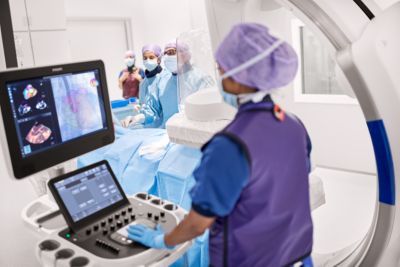
3 ways to enhance cath lab performance
- By Philips
- March 03 2025
- 3 min read
In cardiovascular care, patient satisfaction, cost efficiency, and productivity are key factors in supporting positive outcomes. As an experienced cardiovascular leader, you understand the importance of balancing patient care with the business requirements of your department.
At-a-glance:
- Reducing radiation dose
- Managing AKI risk in PCI procedures
- Standardizing cath lab workflow

Philips, a leader in image-guided therapy solutions, has collaborated with major health systems across the U.S. to address these challenges head-on. Let's explore three lessons learned from Philips customers, highlighting key innovations and collaborations that have led to improved patient outcomes and health system success.
1. Managing radiation dose for patients and staff
Radiation dose management is a critical aspect of delivering safe and effective cardiac care. Nottingham University Hospitals NHS Trust, a regional center for specialty cardiac care, faced the challenge of delivering a high throughput of complex cases while minimizing radiation dose to both patients and staff. They turned to Philips and Azurion, our flagship image-guided therapy platform, to address the challenge.
One of the key advantages of the Azurion system is its ability to manage radiation dose effectively. By using a more efficient detector and ClarityIQ advanced image processing technology, the system allows cardiologists to achieve high-quality diagnostic images with a low dose.
Andy Rogers, Head of Radiation Physics at Nottingham University Hospitals NHS Trust, highlights the benefits of the technology: "One of the key reasons for upgrading the laboratories was to have a more modern system and to be able to manage the operator dose. Of course, that has an impact on patients as well, because many of them come back over the years for repeat visits. For patients that have one procedure after another, cumulative lifetime dose is also important."By leveraging the advanced capabilities of Philips Azurion, the cath lab team at Nottingham University Hospitals NHS Trust is able to deliver high-quality diagnostic images with a low dose. This not only improves patient outcomes but also reduces radiation exposure for both patients and staff.
2. Contemporary PCI practices to manage the risk of AKI
Delivering percutaneous coronary intervention (PCI) to patients with complex coronary artery disease requires precision and careful planning. Dartmouth-Hitchcock Health, New Hampshire's largest academic health system, focuses on achieving excellent patient outcomes while reducing costs. Dr. Amit P. Amin, Associate Professor of Medicine at Dartmouth-Hitchcock Health, shares his insights on using advanced technologies, such as instantaneous wave-free ratio (iFR) and intravascular ultrasound (IVUS), to guide PCI procedures.
Dr. Amin highlights the benefits of using tools like iFR and IVUS to accurately assess the severity and location of ischemia, as well as plan the intervention. "With newer technology like iFR from Philips and the ability to perform co-registration with the angiogram, we can confirm not only where to treat, but also predict the degree to which the treatment will improve flow in the coronary artery," he says. "So not only is the degree of ischemia important, but being able to localize the source of ischemia along the coronary tree is helpful in planning the PCI procedure."
Additionally, Dr. Amin emphasizes the importance of reducing contrast volume in patients at risk of acute kidney injury (AKI). Specifically, how the use of patient-specific strategies can help limit contrast volume based on comorbidities and estimated glomerular filtration rate. By implementing measures like these, cardiology departments can help reduce contrast agent use to help manage the risk of AKI and improve overall patient care.
3. Standardizing workflows for enhanced clinical and operational performance
Standardizing workflows in the cath lab is essential for delivering consistent, high-quality care while improving operational efficiency. Standardization also improves staff satisfaction and increases efficiency by reducing the need for room resets and settings changes. Philips Azurion offers tools and applications that enable clinicians to streamline their practice and reduce variability in the delivery of care.
Furthermore, by using integrated technologies like the Philips IntraSight platform, clinicians can access multiple applications and imaging tools from a single tableside touchscreen monitor, reducing variability and improving workflow efficiency. This level of integration allows for better coordination between different labs, ensuring that every patient receives the same standard of care regardless of the lab they are treated in.
Dr. Karim Al-Azizi, interventional cardiologist and structural heart disease specialist at Baylor Scott & White Health, emphasizes the importance of standardization and integration in delivering patient-centered care. "Think of a loved one undergoing PCI. Whether or not there is kidney disease, every patient should be treated with the same standard of care, with high-quality, low-contrast PCI to limit exposure to a nephrotoxic agent and provide the best outcome," he says.
By standardizing on the Philips suite of coronary solutions, clinicians can access physiology and imaging tools seamlessly. The IntraSight application, fully integrated into the Philips Azurion system, allows clinicians to perform IVUS and iFR measurements, as well as utilize Dynamic Coronary Roadmap for real-time guidance during procedures.
Copy this URLto share this story with your professional network
Sign up for news and updates

Disclaimer
Results are specific to the institution where they were obtained and may not reflect the results achievable at other institutions. Results in other cases may vary.
